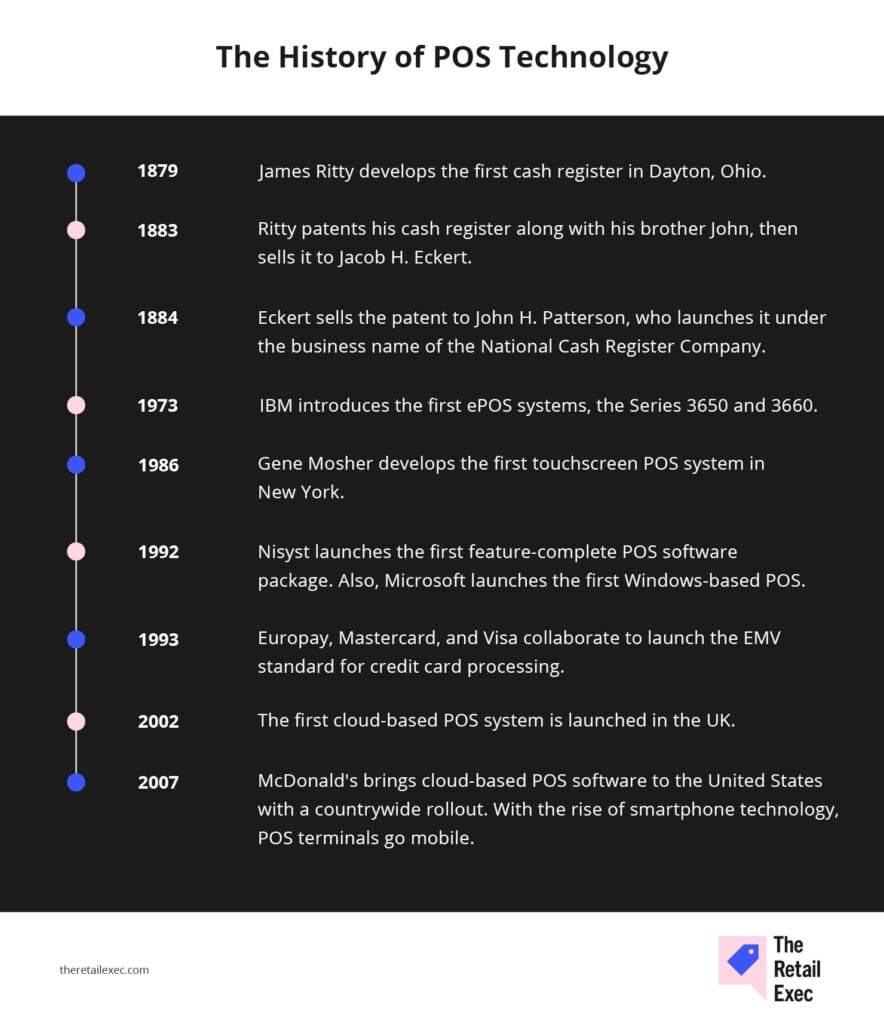Saloons Inspired the Cash Register Revolution: The first cash register, created in 1879 by an Ohio barkeep, laid the groundwork for today's advanced POS systems with its innovative approach to handling transactions accurately and efficiently.
Innovation Born from Necessity: The cash register was a solution to curb employee theft and improve transaction accuracy, showing how necessity drives technological advancements that solve everyday business challenges.
From Bells to Bytes in POS Evolution: Modern POS systems, unlike their 1800s predecessors, now integrate seamlessly with cloud services, enabling features like ecommerce and loyalty programs, showcasing technology’s evolution in business tools.
Old Meets New in Business Tech: Even the most modern POS systems trace their lineage back to simple, mechanical roots, illustrating how historical innovations continue to influence today’s cutting-edge business technology.
Business Solutions—Timeless Needs with New Tools: The core need for reliable and efficient transaction systems remains unchanged, even as technology evolves, highlighting the enduring nature of fundamental business requirements.
Think your sleek POS system has nothing in common with an 1800s saloon? Think again. The history of POS systems is deep.
When an Ohio barkeep cobbled together the first cash register in 1879, he wasn’t thinking about cloud sync, loyalty programs, or ecommerce integrations.
He just wanted his staff to stop skimming cash off the top.
Fast-forward 140+ years, and that clunky mechanical box has evolved into a full-blown business command center—tracking inventory in real time, processing tap-to-pay in seconds, and feeding you data on customer behavior faster than you can say “conversion rate.”
Why does this even matter? Because understanding the history of POS systems isn’t just trivia—it’s insight into how sales technology evolves, how businesses adapt, and what you need to future-proof your tech stack. Discover how to pick the right POS system for your business.
So let’s break down how we got from brass bells and receipt rolls to mobile-first, AI-powered POS platforms—and what that means for modern retail, ecommerce, and everything in between.
Introduction to POS Systems
Let’s get real—your POS system isn’t just where money changes hands. It’s where your business lives and dies.
Every transaction, inventory count, customer detail, and employee action funnels through that system. If it's clunky or outdated, it's costing you money. If it's dialed in? It's making you money while you sleep—especially when your team knows how to use it through proper POS training.
At its most basic, a POS system is hardware meets software—terminals, card readers, receipt printers all connected to cloud-based platforms that track, process, and dissect every sale. But that’s just the surface.
Today’s POS platforms run employee management, sales analytics, loyalty programs, omnichannel syncing, and real-time reporting that tells you exactly what’s working—and what’s bleeding cash.
Here’s where it gets interesting: cash registers have been around for over 140 years, but the systems you’re using today? They’re barely 50 years into their existence.
And in the last decade, they’ve gone from bolted-down machines to cloud-native powerhouses that move as fast as your customers do.
Understanding how this tech evolved isn’t about nostalgia—it’s about knowing why POS systems became essential infrastructure for modern retail and ecommerce.
Because if you know where it came from, you’re better equipped to choose, use, and scale the right tools moving forward.

Where It All Began: Cash, Chaos, and the First POS Hack
Before cloud systems, tap-to-pay, or even electricity, there was James Ritty—a saloon owner in 1870s Ohio with one big problem: his employees kept dipping into the till.
Every lost dollar was a direct hit to his business, and he was fed up.
James Ritty: Saloon owner turned anti-theft tech pioneer
Ritty didn’t set out to invent a point-of-sale system. He just wanted to stop hemorrhaging cash.
So he built a mechanical contraption he called “Ritty’s Incorruptible Cashier”—a no-nonsense machine with metal keys for each sale amount, a bell that rang every time it was used (to alert the owner), and an adding mechanism to total up sales.
The goal was simply accountability.
If the bell rang and no sale was logged, someone had explaining to do. It wasn’t elegant—but it worked. And just like that, the first-ever POS system was born—not to streamline sales, but to stop theft cold.
How NCR turned Ritty’s invention into a sales empire
Ritty’s idea was solid, but he wasn’t a scale guy.
Enter Jacob H. Eckert, who bought the patent and eventually sold it to John H. Patterson in 1884. Patterson rebranded the business as the National Cash Register Company (NCR) and got to work refining the machine—and the pitch.
He didn’t just sell registers. He sold security, control, and operational efficiency, and in doing so, NCR became synonymous with sales tech for decades.
That early success proved one thing: businesses will always invest in tools that protect profits and increase control—a core driver that still fuels POS system evolution today.

The Advent of Electronic POS Systems
For nearly a century, POS tech barely moved the needle—same clunky machines, same manual tracking, same headaches.
Then the 1970s hit, and the industry finally dragged itself into the electronic age.
This wasn’t just a hardware upgrade—it was the beginning of real-time sales tracking, programmable systems, and the first sparks of data-driven retail. Mechanical registers were out. Microprocessors and memory chips were in.
And with that shift came two major milestones that set the stage for the digital POS revolution.
IBM’s electronic cash register—retail meets computing
In 1973, IBM dropped the IBM 3650 and 3660 systems—the first commercial electronic cash registers (ECRs).
These machines replaced mechanical parts with microprocessors and memory, allowing businesses to track transactions, run price look-ups, and generate early sales reports.
For retailers, this was a game-changer: data no longer lived on paper—it lived in the machine.
The IBM 3650 became a staple across retail and grocery chains, proving that technology could deliver control, speed, and insight at the point of sale.
Still, it’s worth noting: retail was behind the curve.
Industries like finance and manufacturing had already embraced computing. IBM’s ECRs helped retail finally catch up—and kickstarted the demand for smarter, faster, and more integrated sales tools.
Gene Mosher’s touchscreen POS
While IBM was optimizing for enterprise, Gene Mosher, a New York deli owner, was inventing the future of POS interfaces.
In 1986, he created ViewTouch, the first POS software with a graphical touchscreen, built on an Atari ST.
It let servers tap menu items on a color screen to place orders, route them to kitchen printers, and even process payments—all without clunky keypads or manual tickets. It was fast, intuitive, and lightyears ahead of what most businesses were using at the time.
Mosher’s touchscreen system wasn’t just innovative—it redefined what a POS could be: interactive, visual, and customer-focused.
His tech shaped the UX standards that modern POS systems are still chasing.

The 1990s: When POS Systems Went Digital (and Payments Got Serious)
The 1990s blew the doors off the POS industry.
Hardware-heavy, proprietary systems were out. Software-first, flexible platforms were in. It was the first time businesses could actually customize their POS setup—not just buy what a vendor told them to.
And the stakes were higher than ever, thanks to credit card fraud skyrocketing and new standards forcing retailers to adapt—or get burned.
From hardware to software: the rise of ePOS systems
The term “ePOS” (electronic point of sale) started making the rounds in the early ‘90s.
This wasn’t just a rebrand—it was a shift in mindset. POS systems were no longer just machines—they were platforms, with software that could adapt, evolve, and integrate with the rest of a business’s operations.
In 1992, Nisyst launched one of the first full POS software packages, kicking off a wave of innovation. But the real tipping point came when systems moved to Microsoft Windows—and with it, accessibility exploded.
Windows opens the floodgates for flexible POS setups
With the release of IT Retail, the first POS software built for Windows, the floodgates opened.
Retailers and restaurants could now mix and match hardware and software, creating custom setups tailored to their business models—not locked into rigid vendor ecosystems.
It also allowed faster software development, meaning more features, more integrations, and more competition in the market.
So, POS systems went from being a cost center to a competitive edge—with businesses able to scale, pivot, and optimize operations at a pace that just wasn’t possible before.
EMV standards force payment security into the spotlight
Meanwhile, payment tech was having its own moment.
In 1993, Europay, MasterCard, and Visa (EMV) teamed up to launch the EMV standard—a global protocol for chip-based cards and secure terminals.
Why? Because magstripe fraud was rampant, and card networks were bleeding money.
For POS systems, this meant one thing: adapt or die.
Terminals needed card readers, PIN pads, and signature capture devices to comply. Businesses that didn’t upgrade faced higher fraud risk, chargebacks, and eventually, regulatory penalties.
This shift also paved the way for faster checkouts, integrated payment processing, and eventual support for contactless and mobile payments—but in the ‘90s, it was about survival and security.

The 2000s: Cloud-Based POS and the Rise of Mobile Retail
The early 2000s were the beginning of the end for on-premise POS systems. Local servers, manual backups, and location-locked data gave way to something more powerful: real-time access from anywhere, at any scale.
Retailers didn’t just gain visibility—they gained speed.
Why cloud POS changed everything for retailers
Cloud-based POS hit the scene in the early 2000s, starting in the UK and quickly gaining traction with enterprise brands. In the US, McDonald’s rolled out cloud POS in 2007, proving that even high-volume, fast-paced operations could go digital without missing a beat.
For operators, cloud meant:
- No local installs or maintenance
- Live syncing of sales, inventory, and customer data
- Multi-location visibility with centralized control
- On-demand reporting from any device
Suddenly, managers could make decisions in real time—adjust pricing, reroute stock, or pivot marketing across locations without ever stepping into the store.
From smartphones to full-stack mobile POS
As smartphones took off in the late 2000s, retailers realized something huge: they were holding full-fledged POS terminals in their hands.
Thanks to NFC, built-in cameras, and app ecosystems, phones and tablets became portable cash registers.
Line-busting in stores? Easy. Pop-up retail? No problem. Mobile POS turned any employee into a checkout lane and gave retailers the freedom to break from the counter entirely.
This also set the foundation for the omnichannel shift—where ecommerce, in-store, and mobile sales all fed into the same cloud-based system, in real time.

Cloud made scaling easier—but not simpler
While cloud POS unlocked massive benefits, it also came with trade-offs. Vendor lock-in became a real issue.
Data portability? Not always guaranteed. And the sheer number of players in the market led to fragmented tech stacks and integration headaches.
Retailers had to get savvier. Choosing a POS system wasn’t just about features—it was about ecosystem strategy. Does it play nice with your accounting software? Your ecommerce platform? Your loyalty app?
In other words: Cloud made scaling possible—but only if you had your architecture game tight.
Modern POS Systems and the Future of Sales Tech
POS systems have come a long way from tracking cash in a drawer.
Today, they’re less like sales tools and more like operating systems for your business—running transactions, inventory, customer engagement, workforce management, and analytics in one real-time, cloud-based engine.
POS is now your business command center
Modern POS systems do more than ring up sales—they orchestrate your entire operation. That includes:
- Real-time inventory sync across channels
- Automated reordering when stock runs low
- Customer profiles that track purchase behavior, preferences, and lifetime value
- Integrated loyalty programs, promotions, and gift card systems
- Plug-and-play integrations with CRMs, ecommerce platforms, ERPs, and accounting tools
The best systems unify all this data so you can make decisions based on what’s actually happening, not gut instinct.
The AI layer: Prediction, personalization, and fraud prevention
AI is no longer some far-off tech buzzword—it’s embedded in the smartest POS systems on the market. We’re seeing real-world applications like:
- Predictive inventory that forecasts demand spikes based on historical and seasonal trends
- Automated customer segmentation to power personalized marketing and upsells
- Anomaly detection that flags suspicious transaction patterns before human eyes ever catch them
- AI chat tools built into POS support systems to resolve staff or customer issues instantly
And as generative AI improves, expect to see POS-integrated virtual assistants that help staff optimize floor layout, create promotions, or build smarter schedules based on foot traffic trends.

What’s next: Automation, integration, and POS as strategy
The next era of POS is about seamless automation, multi-platform integration, and data as leverage. Your POS is no longer an isolated tool—it’s a strategic node in your revenue engine.
Expect to see:
- Fully automated back-office workflows (think: reconciliation, refunds, order routing)
- Connected ecosystems where POS, ecommerce, logistics, and marketing platforms share data in real time
- Hyper-specialized vertical POS systems tailored to niche retail models and customer journeys
The businesses that win? They won’t just use POS to process payments—they’ll use it to predict outcomes, optimize operations, and outmaneuver the competition.
From Bell-Ringing Boxes to Business Intelligence Engines
What started as a mechanical hack to stop bartenders from skimming tips has evolved into one of the most powerful tools in modern commerce.
POS systems now do so much more than take payments—they're about running smarter, faster, and leaner operations at scale.
If you're in retail, hospitality, or ecommerce, your POS isn't a backend utility—it's your front line, your data pipeline, and your growth lever all rolled into one.
And as AI, automation, and omnichannel complexity ramp up, your ability to choose, configure, and evolve your POS stack might just be what separates you from the businesses that stall out.
So whether you’re optimizing your current system or shopping for something future-proof, remember: your POS history is your playbook—and the future’s already in motion.
Retail never stands still—and neither should you. Subscribe to our newsletter for the latest insights, strategies, and career resources from top retail leaders shaping the industry.


